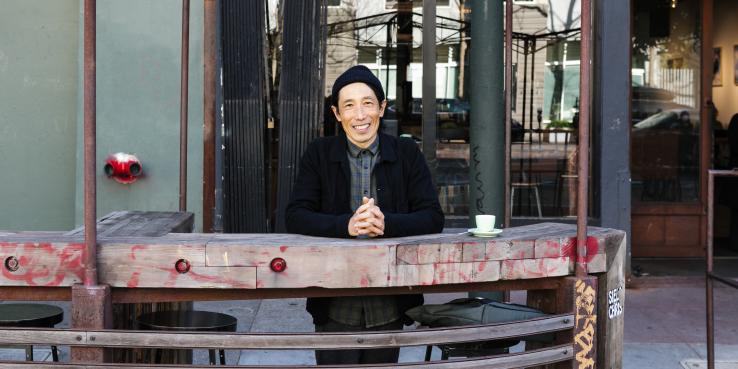This year, SPUR is celebrating staff members — a.k.a. “Spurritos”— who have served the organization for 10 years or more. This month we profile Strategy and Operations Director Lawrence Li, who keeps the SPUR Urban Center in San Francisco — and our remote work across the Bay Area — humming seamlessly despite global pandemics and other unforeseen disruptions.
Lawrence was instrumental in SPUR’s move into the Urban Center in 2009, and in 2020 he traveled around the region to hand-deliver laptops and monitors to employees during shelter-in-place orders. In addition to managing all of our technology and physical spaces, he also created and managed our budget for nine years. In his 15 years at SPUR, Lawrence has onboarded every new employee as the staff has grown from 15 employees to 33. An avid bicyclist and a board director to multiple nonprofit organizations, Lawrence is known among SPUR staff for his eye for clean design and his deep dedication to both urbanism and minimalism.
Name: Lawrence Li
Title: Strategy and Operations Director
Start Date at SPUR: March 2007
Employees onboarded: 114
Office space remodels overseen: 6
SPUR city trips attended: 12
Office equipment homes deliveries during the pandemic: 25
Average miles biked in a month
What first drew you to working at SPUR?
I have always been drawn to the multicultural activity of cities. That brought me to Los Angeles for college, but the car-oriented landscape fueled contemplation about dystopia. In contrast, great travel experiences made me ask, “Why can't I live like this back home?” I moved to San Francisco
Back in 2007, bicycling in San Francisco required a certain level of fearlessness.
At that time the SPUR community was building a new home for sharing ideas, which would eventually become the Urban Center. Museums inspire me, and I wanted to support the effort as both a member and a nonprofit administrator.
Has working at SPUR changed the way you see urban issues?
Before I started, housing policy didn't interest me. Although rent has always sucked up most of my paycheck, I would glaze over the housing programming. It is now clear to me that this lack of attention and urgency to building more housing results in a city that is less diverse and dynamic than it could be.
What accomplishment at SPUR are you most proud of?
Dodging suggestions to paint our cinder block walls. I want to see the materials and infrastructure that surround us.
What’s a favorite SPUR memory that you can share?
I can't point to a specific memory, because it has been a continuous buildup of incremental moments: moving into the Urban Center, refinancing it
What are you working on now?
I can finally put my biology degree and training to good use as SPUR’s pandemic school nurse. Designing the shift to remote — and then hybrid — work has been a fascinating intersection of my focus areas of HR, IT and office management. Of course, because our staff and board had already been working together remotely across the region, we were prepared for the shift.
What do you do when you’re not managing SPUR’s operations?
Because our urban planning systems resist change, great public space requires hands-on action, and SPUR's highly engaged board of community leaders have inspired me to act likewise. I have been invited to bring my perspective to boards of the SF Bicycle Coalition, Yerba Buena Community Benefit District and, most recently, Yerba Buena Gardens Conservancy.
More passively, I find inspiration in exploring issues of the day through contemporary art and performance. YBCA, ODC and Counterpulse are my favorite institutions for accessing our art community. It has become clear to me that the arts ecosystem needs the stability of affordable housing and space.
Meanwhile, you can find me out there enjoying coffee on the sidewalk on Valencia or Market Street, biking to preschool, or running up Twin Peaks or in Golden Gate Park with the SF Frontrunners.
What’s one of your favorite activities in the Bay Area?
Oakland First Fridays embodies that open, creative, can-do, celebratory, together sprit of cities that I love.
If you could wave a magic urbanist wand and make one proposal or idea come true, what would it be?
Some CEQA reform magic would get us better cafes, more bike lanes
